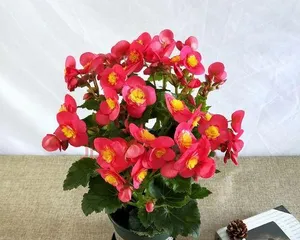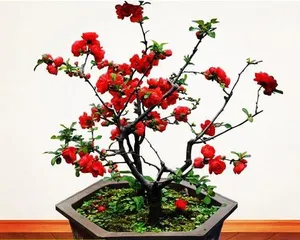Begonias have become one of the most beloved flowers due to their graceful posture and vibrant colors. However, because they require high humidity and light conditions to grow, many people believe they can only be planted outdoors. In fact, begonias can be grown and cared for indoors as long as appropriate environmental conditions and techniques are followed, allowing them to bloom beautifully even inside your home. Below is a detailed introduction on how to care for begonias indoors.

Selecting the Right Variety
Choosing a begonia variety suitable for indoor growth is the first step to successful cultivation. It is recommended to select varieties that prefer shade and adapt well to temperature changes, such as Tulip Begonia, Berry Begonia, and Glossy-leaved Begonia.
Preparing the Potting Soil
When caring for begonias, use potting soil that is loose, breathable, and retains moisture well. You can refer to the natural environment where begonias grow by adding appropriate amounts of leaf mold and peat moss to improve soil acidity and organic matter content.

Controlling Water Amount
Begonias require adequate water for growth, but overwatering should be avoided. When caring for begonias, pay attention to controlling the amount of water to prevent soil from becoming too wet and causing root rot.
Maintaining Appropriate Temperature
Begonias thrive in warm and humid environments. When growing them indoors, maintain an appropriate temperature range, avoiding excessive heat or cold. Generally, the temperature should be kept between 15°C and 20°C.
Providing Proper Shade
Begonias prefer cool and moist environments. They can be placed in relatively dark positions indoors while ensuring proper shading. Especially during hot summer periods, it is important to provide adequate sun protection.

Increasing Air Humidity
Begonias prefer humid environments. When growing them indoors, pay attention to increasing air humidity. You can use a humidifier or place humidity trays around the pot to maintain an appropriate humidity level.
Applying Proper Fertilization
Begonias require adequate nutrients during their growth period. You can choose organic fertilizers or compound fertilizers for application. However, avoid over-fertilization to prevent soil acidification or root burning.
Preventing Pests and Diseases
Begonias are susceptible to various pests and diseases during their growth, such as aphids, powdery mildew, and leaf mold. Pay attention to early detection and treatment when caring for them, using sprays or other methods for prevention and control.
Pruning Timely
After the blooming period, timely pruning of begonias promotes new branch growth and flower development. Removing wilted and diseased leaves maintains the overall health of the plant.
Avoiding Water Stagnation
When growing begonias indoors, avoid water stagnation at the bottom of the pot, which can affect plant growth and cause disease. You can add drainage holes at the bottom of the pot or use materials like sand and gravel to improve drainage.
Regularly Changing Soil
Begonias consume nutrients and organic matter in the soil during their growth process, so regular soil replacement is necessary. Generally, soil should be changed every 1-2 years.
Timely Transplanting
As begonias grow, their roots and stems expand, requiring timely transplantation. During transplanting, ensure the root system remains intact and water and fertilize promptly afterward.
Rational Use of Sunlight
Begonias require sufficient sunlight to promote growth and flowering. When growing them indoors, place pots in sunny locations or near windows.
Preventing Elongation
Elongation is a common problem with begonias that leads to poor plant growth and lack of flowering. When caring for them, avoid elongation by providing adequate fertilizer and water supply.
Caring for begonias indoors requires attention to many details and techniques, but once you master the appropriate environment and methods, you can successfully enjoy beautiful blooms indoors. We hope this begonia care guide will help fellow flower enthusiasts enjoy the beauty and charm of begonias even within their homes.